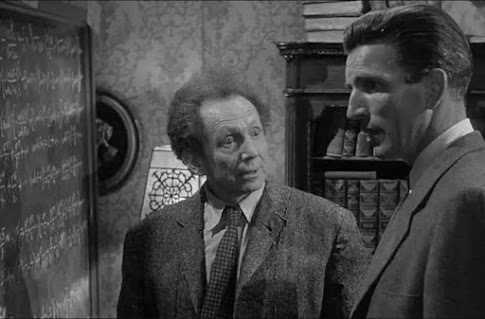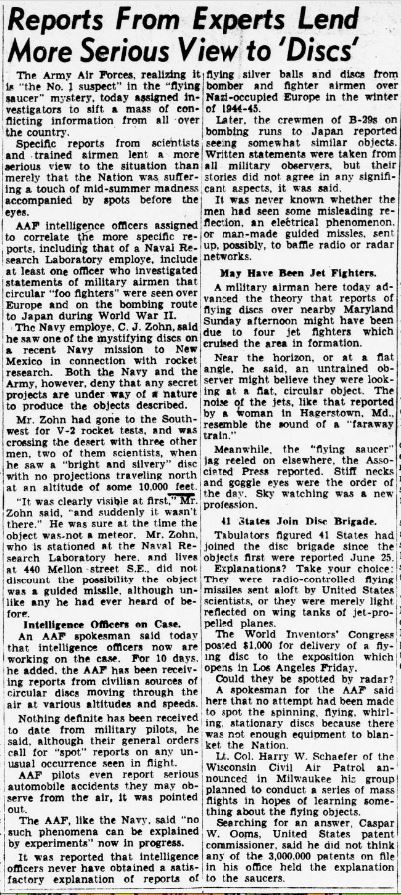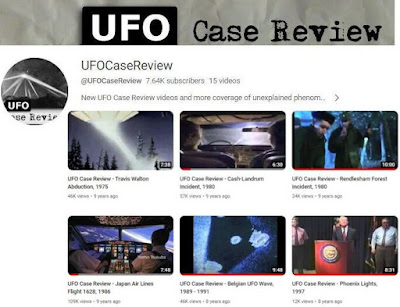This article, like many at The Saucers That Time Forgot, started with a question. Finding a listing from a television anthology series from 1950, one of the first dramas written about UFOs, we asked: What was "The Flying Saucers?"
The plot almost sounds like it could have been an episode of a later show, Rod Serling's The Twilight Zone: Peaceful extraterrestrials in saucer-shaped spaceships contact a prominent scientist on earth via telepathy. They are in search of a new home for their people. The scientist carries the news to the world, but he’s thought to be mad. Then comes the twist ending.
What makes this story important was when it was told. Only a few months earlier, Donald Keyhoe’s article in True magazine had been released, “The Flying Saucers are Real,” which got the public seriously considering that maybe aliens from space were here. It was before any science fiction television anthology shows or any major motion picture featuring aliens in flying saucers. It may have been the first serious treatment of contact with aliens on television, and it’s notable that instead of invading space monsters, the extraterrestrials were depicted as intelligent and peaceful.The Hands of Destiny
Hands of Murder was a crime and suspense half-hour dramatic anthology television series from the DuMont Television Network. It aired from 1949 to 1952, later retitled Hands of Destiny. Created by Lawrence Menkin and written by him in partnership with Charles Speer, the series was performed and broadcast live. Unfortunately, no known recordings of episodes survive.
 |
| 1950 Radio Annual |
The series was described at The Retro Set, “Monstravaganza:Classic TV Horror!” by Terence Towles Canote:
Hands of Murder debuted on 7 October 1949 on the DuMont Television Network… [It] was produced on a shoestring budget and aired live. In fact, according to Tim Brooks and Earle F. Marsh in The Complete Directory to Prime Time Network and Cable Shows: 1945-Present, Hands of Destiny was notable for its lack of sets and props. Lighting and camera angles were used to suggest the setting. Despite the low budget, Hands of Destiny received sterling reviews from critics, with even Walter Winchell praising its camera work.”
The show’s co-creator Lawrence Menkin is more well-known for his role in launching the DuMont program, Captain Video and His VideoRangers, the first science fiction television series on American television. It ran from 1949-1955.
Hands of Destiny departed radically from its standard format of depicting crime stories in an episode by Menkin and Speer concerning contact with UFOs.
The Flying Saucers
The Hands of Destiny episode, “The Flying
Saucers” was originally broadcast on April 28, 1950, and it was shown again or
rerun in some areas in June. The episode listing as presented in the Press-Telegram
(Long Beach, CA) Wednesday, June 7, 1950:
“9:30 - KTLS - Viewer imagination will determine whether the drama, “The Flying Saucers” is fact or fiction in tonight’s edition of "The Hands of Destiny." A man is thought to be a lunatic when he claims to be contacted by visitors from outer space, but a surprise ending clears him of the charges.”
It wasn’t just any man. He was a scientist, one that
closely resembled Albert Einstein.
 |
| Bruno Wick starred as the scientist. |
Below is a clipping of the review of “The Flying Saucers” by June Bundy from Billboard, May 20, 1950, followed by the complete text.
 |
| Billboard, May 20, 1950 |
Hands of Destiny
Reviewed Friday (28), 8-8:30 p.m. Sponsored by New York Chevrolet Dealers' Association thru Campbell-Ewald via WABD, New York. Director, Frank Bunetta. Writers, Lawrence Menkin and Charles Speer. Music, Lew White. Cast: Bruno Wick, Ruth White, James Maloney, Richard Sanders, Ray Mulderick, Frederick Draper.
Hands of Destiny is the new monicker for the Charles Speer-Larry Menkin Hands of Murder program, and the title switch, which considerably broadens the show's script scope, coincides with the series' bow as a co-op show under local sponsorship of the New York, New Jersey and Connecticut Chevrolet Dealers' Association.
In line with the public's current fetish for science fiction, last Friday's drama centered around flying saucers. The space yarn provided a natural showcase for the series' unique camera technique, which integrates lengthy line-up of short terse scenes into a smooth whole, via multi close-ups and unusual technical effects.
It seemed that the whirling disks represented an attempt by visitors from space to contact earth's most intelligent inhabitant, a thinly disguised version of Dr. Einstein. Utilizing mental telepathy (the saucer face was literally made of light and invisible to human eyes), the disks told the professor they were looking for a world to call home, and earth was being screened for the honor. In spite of their lack of substance, tho, the saucer set was darned choosy and ultimately decided to by-pass war-torn earth in favor of another planet location. By that time Joe Public had labeled the professor a crackpot, so he and his wife joined the saucer safari into space.
Ingenious Production
Production-wise the airer was easily one of the most ingenious dramas ever staged on video. Parts of the script were unnecessarily padded with trite melodrama, but the story struck sparks with its opening shot of shimmering space, a pulsating "talking" light ray effect and a powerful close-up of the professor's distorted face at the climactic point of "brain contact" with the light men. Unfortunately, tho, with the exception of Bruno Wick as the professor and Richard Sanders as the "voice of a flying saucer," all acting wasn't on a par with the production.
The Chevrolet commercials followed a varied pattern, including a conventional-type film clip of new models and an imaginative animated take-off on the headless horseman. The latter was positively pun-happy. (i.e. "I lost my head over Chevrolet… I flipped my lid over the service…. and you get a head with Chevrolet.")
June Bundy.
Based on the review, we can see that the script by Menkin
and Speer had some interesting concepts percolating about flying saucers. The
next year, we’d see similar ideas explored in Hollywood movies. Among them was
the notion that aliens were peaceful while our world was far from it. Such an idea
was at the heart of the classic 1951 film Day the Earth Stood Still,
where a flying saucer landed with a warning from space. Klaatu sought the help
of “the smartest man on earth,” physicist Dr. Jacob Barnhardt, played by Sam
Jaffe, whom reviewers noted was “obviously based on Prof. Albert Einstein.”
 |
| The Day the Earth Stood Still - Sam Jaffe as Prof. Jacob Barnhardt |
The UFO episode of Hands of Destiny was a bold departure from the series usual storylines and the favorable review from Billboard may have proved to the television industry that the public had an appetite for flying saucer programming.
.
. .
For more on Albert Einstein and UFOs in fact and fiction, see:



































.jpg)









